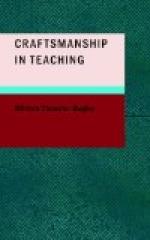V
In the teaching of history in the elementary school, the biographical treatment is followed in the later grammar grades by a systematic study of the main events of American history. Here the method is different, but the purpose is the same. This purpose is, I take it, to show how our ideals and standards have developed, through what struggles and conflicts they have become firmly established; and the aim must be to have our pupils relive, as vividly as possible, the pain and the struggles and the striving and the triumph, to the end that they may appreciate, however feebly, the heritage that is theirs.
Here again it is not the facts as such that are important, but the emotional appreciation of the facts, and to this end, the coloring must be rich, the pictures vivid, the contrasts sharply drawn. The successful teacher of history has the gift of making real the past. His pupils struggle with Columbus against a frightened, ignorant, mutinous crew; they toil with the Pilgrim fathers to conquer the wilderness; they follow the bloody trail of the Deerfield victims through the forest to Canada; they too resist the encroachments of the Mother Country upon their rights as English citizens; they suffer through the long winter at Valley Forge and join with Washington in his midnight vigils; they rejoice at Yorktown; they dream with Jefferson and plead with Webster; their hearts are fired with the news of Sumter; they clinch their teeth at Bull Run; they gather hope at Donelson, but they shudder at Shiloh; they struggle through the Wilderness with Grant; tired but triumphant, they march home from Appomattox; and through it all, in virtue of the limitless capacities of vicarious experience, they have shared the agonies of Lincoln.
Professor Mace, in his essay on Method in History, tells us that there are two distinct phases to every historical event. These are the event itself and the human feeling that brought it forth. It has seemed to me that there are three phases,—the event itself, the feeling that brought it forth, and the feeling to which it gave birth; for no event is historically important unless it has transformed in some way the ideals and standards of the people,—unless it has shifted, in some way, their point of view, and made them act differently from the way in which they would have acted had the event never occurred. One leading purpose in the teaching of history is to show how ideals have been transformed, how we have come to have standards different from those that were once held.




